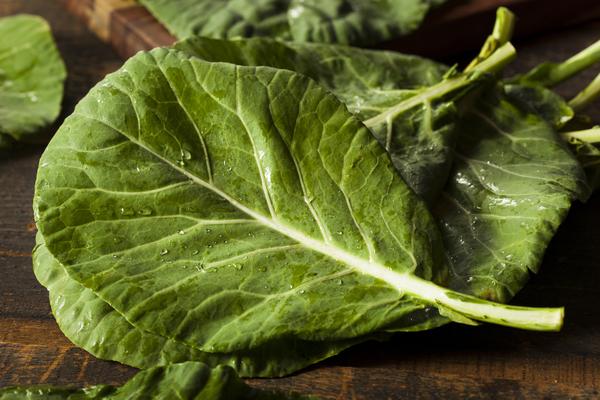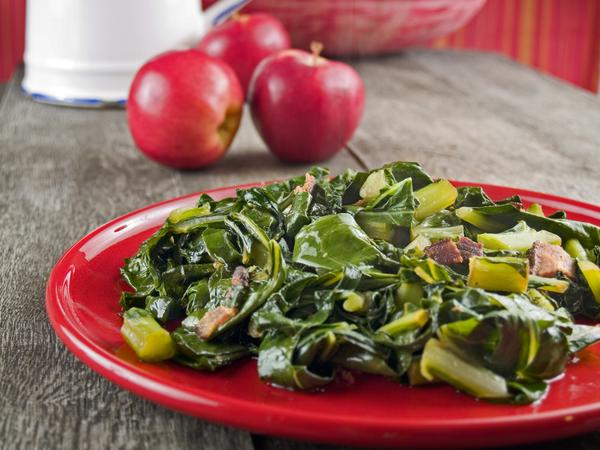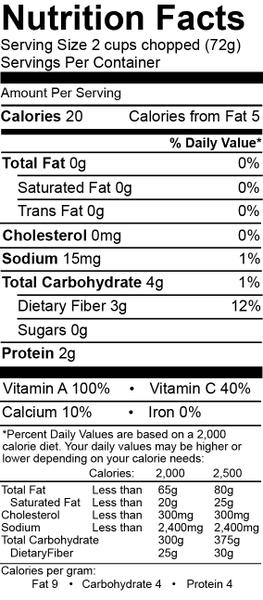Collard greens grow as a loose bouquet rather than a tight “head” like other cabbages. Packed with vitamins and minerals, they are one of the most popular garden vegetables in the South and are rapidly becoming a delicacy in northern states as well.
Growing
When and Where to Plant
The collard is a cool-season crop that should be grown during early spring or fall. Direct seed midsummer or early spring. Set transplants out in early spring or late summer. The mature plant will withstand frosts and light to medium freezes.
How to Plant
Precision seeders reduce seed use by 40 to 70 percent and produce more uniform stands that require little thinning and are better weed competitors. Uniform stands are easier to grow and harvest. Place seed in moist soil usually ½ to ¾ inch deep, but never deeper than 1 inch. If moisture is not adequate for germination in the top ¾ inch of the soil, water should be applied. Frequent irrigation is important in obtaining good stands in hot weather (¼ inch per day at midday).
Spacing
Spacing depends on how the crop will be harvested. If the plants will be cut when half grown, space them 10 to 15 inches apart. If they will be harvested when full grown, space them 15 to 18 inches apart. If young collard plants will be harvested, similar to mustard greens, space the plants 2 to 4 inches apart. Space rows 36 to 42 inches apart for conventional systems. However, multi-row beds of 2 to 4 rows on 38 to 60 inch centers provide greater yields and improved quality. In such a system, space rows on each bed 12 to 18 inches apart. This provides rapid ground cover, fewer weeds, and more tender growth.
Soil Requirements
Leafy vegetables require quick, continuous growth for best quality. They need ample nitrogen for good green color and tender growth. Test and amend the soil according to the recommendations at least seven days before planting. You may need to side-dress three to five weeks after the seed comes up or two to three weeks after transplanting.
Collards may be grown in a variety of soils. Heavier loamy soils will produce the greatest yields. Lighter, well-drained, sandy soils are best for early spring crops. Soils should be well drained, rich in organic matter, and have a pH of 6.0 to 6.5.
Harvesting
Collards can be harvested using several techniques:
- Cut entire plants when very young. The plant will grow back and can be harvested multiple times.
- Cut entire plants when about half grown.
- Cut entire plants when full grown.
- Harvest tender leaves from full-grown plants.
Recommended Varieties
Vates, Carolina Improved Heading (or Morris), Georgia Southern, Blue Max, and Heavi Crop have consistently done well in North Carolina. For additional recommendations, visit Cornell University's Vegetable Varieties for Gardeners database.
Purchasing
- Choose bunches with dark green leaves with no yellowing.
- Refrigerate collard greens in a plastic bag for up to five days.
Preparing
Trim stems and woody pieces, and rinse collards thoroughly to remove any traces of grit. Chop into pieces, as needed, for recipes.
Freezing
Start with the freshest greens you can find—about a handful per serving. Blanch the washed, trimmed greens in a large pot of boiling water for 3 minutes, then immediately immerse in a bowl of ice water. Drain thoroughly and place in freezer-safe storage containers, removing as much air as possible to prevent freezer burn. Freeze immediately.
Recipes
|
Greens and Okra
In a large saucepan, sauté onions in oil until golden brown. Add remaining ingredients except lemon. Simmer over low heat, covered, until greens are tender. Squeeze lemon over top of greens and okra mixture just before serving. |
|
Shrimp and Collard Greens Stir-Fry Ingredients:
Trim the ends off the stems of the greens and separate the leaves. Clean under running water and drain. Cut stems into 1-inch pieces, and cut the leaves into wide ribbons. Finely mince garlic and grate fresh ginger. Add canola oil, sesame oil, and ginger to a cold pan and heat on medium-high heat. When the herbs become fragrant and just begin to turn brown, add the stems of the collards. One minute later add the collard leaves and the shrimp. Toss well to coat with the oil, and cook until stems become tender and the shrimp turns pink, about 3 minutes. |
|
Spicy Collard Greens Ingredients:
Wash and cut collard greens. Add all ingredients to a large skillet with just enough water to cover. Simmer over medium heat for 25 minutes. Serve. |
|
Scrumptious Collard Greens Ingredients:
Rinse greens well. Remove stems from leaves. Cut leaves into 2-inch pieces. In an 8-quart saucepot, heat oil over medium heat until hot. Add garlic and cook 30 seconds or until golden, stirring constantly. Add as many collard leaves as possible, broth, vinegar, salt, sugar, and crushed red pepper, stirring to wilt greens. Add remaining greens in batches. Cover saucepot and cook greens 45 minutes or until very tender and most of liquid evaporates, stirring occasionally. |
Recipes in this section were adapted from information found at Fruits & Veggies—More Matters®.
Top 10 Ways to Enjoy Collard Greens
- Meat and Potatoes. Cook sliced potatoes until almost tender. Add chopped collard greens and sliced low-fat turkey sausage. Cook until collard greens are tender and sausage is thoroughly cooked.
- A Gourmet Brunch. For an open-faced sandwich that’s perfect for brunch, place steamed collard greens over freshly baked whole wheat bread and top with prosciutto.
- Greens and Okra. Combine these two traditional southern ingredients in a saucepan with olive oil, chili peppers, onions, and lemon in the Greens and Okra recipe.
- Add More A. For a sweet dish packed with vitamin A, stir-fry collard greens with fresh tomatoes, sun-dried tomatoes, and roasted red peppers.
- Sizzle ‘em. Collard greens are a great addition to any stir-fry. Try them in place of bok choy with garlic, shrimp, ginger, sesame oil, and brown rice.
- Green Eggs and…Greens. Try making your own version of the novelty dish by serving stir-fried greens with fried eggs, mix greens into scrambled eggs, or fold them into an omelet.
- Lose the Lettuce. Use collard greens instead of lettuce. Try it as a fresh salad base, on tacos, in wraps, or on top of sandwiches.
- The Classic. For a quick side dish, mix collard greens with chicken broth, garlic, and salt in a saucepan. Let greens simmer on low heat until ready to serve.
- Noodles n’ Greens. Add chopped collard greens when pasta is about 5 minutes from being done. Season with a small amount of sesame oil, sesame seeds, and salt.
- Southern Style. Southern cuisine is known for its spicy dishes. Combine collard greens, onions, chicken broth, and red pepper flakes (see the Spicy Collard Greens recipe).
This section adapted from information found at Fruits & Veggies—More Matters®.
Acknowledgments
The authors wish to express appreciation to Chris Gunter, Rachel Herring, Debra Ireland, Issac Lewis, Chantel Lumpkin, Karen Neill, and Linda Brandon for their assistance in preparing this publication.
Publication date: June 22, 2020
AG-808-02
N.C. Cooperative Extension prohibits discrimination and harassment regardless of age, color, disability, family and marital status, gender identity, national origin, political beliefs, race, religion, sex (including pregnancy), sexual orientation and veteran status.




